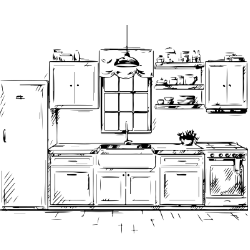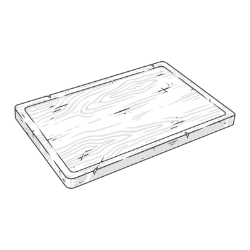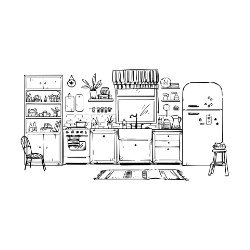
Range Hood Dimensions: Your Complete Guide

Installing a new range hood in your kitchen? If you’re not sure which size you should get, you’ve come to the right place.
Our technical team will walk you through how to correctly measure the dimensions for your range hood. We’ll also share some tips and things to consider to make sure you get the best range hood for your kitchen!
Measure Your Range Hood in 3 Simple Steps
Although there are different types of range hoods depending on the style of your kitchen, the following steps will be able to help you get the correct dimensions you require.

So, whether you have range hood mounts, canopy hoods, ductless range hoods, island range hoods, whatever you have or are planning to buy, this step-by-step guide is all you need!
Let’s get started.
What You’ll Need
- Tape measure
- Pen and paper for notetaking

Step 1: Get Cooking Surface Dimensions
Take your measuring tape and take the width of your cooktop.
Pin down the edge of the measuring tape to the edge of your stove and extend it until you reach the other end.
On average, cooktops, stoves, and kitchen ranges have a width of 30-36 inches. However, if your kitchen is on the smaller side, the cooking surface is at around 24 inches.
Step 2: Get Hood Width Dimensions
The rule of thumb for most range hoods is this:
Your range hood size should be a size wider than your cooktop. For hood dimensions, remember the 3-inch rule: your range hood should be three inches wider on each side.
For example, if you have electric cooking surfaces that measure 30 inches, your range hood should be 36 inches.
For Those With Cabinets
Make sure your range hood will fit in between the cabinets. Take your measuring tape again to see which type of range hood will fit in the space.

For Those With Open Areas (No Cabinets)
You have unlimited options on how you want to style your range hood.
The important part is for you to be able to measure your gas or electric cooktop correctly so you know the correct size for your range hood.
Step 3: Measure Height and Distance From Cooking Surface
The last thing you need to do is to know the distance between your range hood and the cooking surface.
You want to have ample space (or you might knock your head every now and then). It’s also good to check with your local building codes if they require anything specific.

Check with the manufacturer’s height recommendation as well in order to find the optimum clearance.
For reference, here are the typical clearances depending on the type of your cooking range:
- Electric range or cooktop: 2 feet or 24 inches
- Gas range or cooktop: 27 inches
- Maximum height clearance: 36 inches
What to Look for in a Range Hood
More than the usual factors like price, and range hood size, there are four other things you need to take into consideration.
Power or Venting Strength
The main job of a ventilation hood is to pull all air from the cooking surface. The ventilation system ensures your kitchen stays fresh and odor-free.
These are your best buddies to help you eradicate moisture from cooking grease or grilling as well as to regulate the heat inside the kitchen.

You’ll be able to gauge the power or airflow capacity of your range hood which is measured in cubic feet per minute or CFM.
Needless to say, the higher the number, the greater the capacity to replace kitchen air at a certain period of time.
Do you need a high CFM Hood? If you spend normal hours cooking in the kitchen, a powerful CFM hood might just be a waste of money and is not completely necessary.
To give you an idea, 200-300 CFM is the average for those who have a residential range. Commercial-style restaurants need a powerful range hood that tends to have 900 CFM and above.
Ventilation Method
There are basically two types of range hoods: Ducted hoods or external Range Hoods and recirculating Hoods.

Ductwork range hoods expel the kitchen air.
To make this possible, you need exhaust ducts that are mounted to the exterior wall. Oftentimes, as these vent hoods require ductwork beneath or above, they may need professional installation.
- A ducted hood is great for those who live in a standalone house or own an apartment. Otherwise, it may be hard to install the equipment or get approval from your landlord to do so.
- Recirculating hoods, on the other hand, function and clean air through carbon or charcoal filters.
The most common is the charcoal filter which does a great job in neutralizing odor. They do not vent air outside but rather, they pull in the air, process it, and expel the air back to the kitchen.

To make sure these are at their optimal performance, the filters need bi-annual maintenance, sometimes more depending on how much you use your kitchen.
Compatibility
Although hoods can generally process all air and smoke from various cooktops, it’s best to double-check with the manufacturer if your range hood is compatible with your stove.
Electric stoves emit less smoke, which means an average size and CFM would be enough. A gas cooktop, however, might need a more powerful range hood, especially if it’s a big and enclosed kitchen.
Style
Range hoods can be considered an eyepiece in your kitchen.
As they are huge and protrude above your kitchen range, they often stand out.

The safest, easiest, and go-to range hood is a canopy hood. In addition to different shapes, you can also choose from glass canopies or canopy hoods with LED [1].
Types of Range Hoods
These are the most common range hoods in the market that follow the 3-inch rule:
*Note: For these kinds of range hoods, it's important to also get the proper ceiling height or distance to your range top.
For Residential or Those With Limited Space - Standard or Retractable Downdraft Hoods
For those with a downdraft hood, take note that the hood should always match the range width.

It should have the same width - not an inch more or less.
- Moreover, downdraft hoods are usually mounted directly behind.
- It is also crucial to check if the cabinet below measures 24 in depth. More complex installations would require a minimum countertop depth of 24 inches.
- These are popular residential ranges because they are compact and do not take up any cabinet space.
If you still want a standalone range hood that is not close to the cooking surface, you can also check:
- Undercabinet hoods - if you have pre-installed cabinets above your cooking surface
- Cabinet range hoods - best for those ample space in-between cabinets
- Over-the-range microwave hoods - space savers
Custom Range Hoods
For those who have a custom size range hood, the way to increase ventilation would be by adding range hood inserts.
They are a little smaller than your custom size range hood, normally by two inches.

Additions for Big Kitchens
- If you have a commercial-style kitchen, you might want to consider fortifying your hood vent with a chimney extension.
- You can also purchase a makeup air kit. These complement powerful range hoods by pulling more air into your home when the air pressure is suboptimal.
Frequently Asked Questions
What Size Range Hood Would I Need for a 36″ Range?
Always add 6 inches to your cooktop to get the right range hood. Thus, if you have a 36” range, go for a 42″ range hood.
Can I Install a Range Hood Even if I Have Cabinet Installations?
Yes, there are a number of discrete and noninvasive vent hoods you can choose from if you already have cabinets preinstalled.
How Far Should Your Range Hood Stick Out?
There are varying range hood sizes but make sure you get the one that’s right for your kitchen range. You want to have ample cooking space and a humongous range hood would eliminate that.
Following the 3-inch rule, your range hood should not be more than three inches wider on the left and three inches on the right, or 6 inches wider in total than your kitchen range.
Conclusion
There you have it! Our team hopes that this guide gave you a clearer idea of the proper range hood dimensions and type to get for your new hood.
Pop in your brand new vents and let's get ready to cook!





